day of the dead
**💀🌍 Why the World is Falling in Love with Day of the Dead: A Global Party You Can’t Miss 🌍💀**
Alright, folks, gather ’round. We need to talk about the hottest global trend that’s got everyone from Tokyo to Texas dusting off their sugar skulls and breaking out the marigolds. That’s right, we’re diving headfirst into the vibrant, colorful, and slightly spooky world of **Day of the Dead (Día de los Muertos)**. This isn’t just a Mexican holiday anymore; it’s a full-blown international sensation. But why? Let’s break it down.
### **Cultural Context: More Than Just a Pretty Skull**
Day of the Dead, celebrated on **November 1st and 2nd**, is a Mexican tradition with roots tracing back to ancient Mesoamerican cultures. It’s a time to honor and remember deceased loved ones, blending indigenous Aztec rituals with Catholic influences. Families create **ofrendas** (altars) adorned with photos, candles, marigolds, and the favorite foods and drinks of the departed. The idea is that the spirits of the dead return to visit their families during this time—talk about a family reunion with a twist!
### **Why Is It Trending Globally?**
1. **Instagram Gold**: Let’s be real—Day of the Dead is **aesthetic goals**. The vibrant colors, intricate sugar skulls, and elaborate altars make for some seriously stunning Instagram content. From makeup artists to travel bloggers, everyone’s jumping on the bandwagon to capture that perfect #DayOfTheDead shot.
2. **Cultural Appreciation (and Appropriation?)**: While the holiday’s growing popularity is a testament to its beauty and significance, it’s also sparked debates about cultural appropriation. As more people around the world embrace the tradition, it’s crucial to remember its roots and honor its cultural context. Think of it as borrowing a friend’s outfit—it’s cool to admire, but don’t wear it to a party without understanding its significance.
3. **A Global Need for Connection**: In a world that often feels disconnected, Day of the Dead offers a poignant reminder to celebrate life and remember those we’ve lost. It’s a universal theme that resonates with people everywhere, making it a perfect fit for our collective emotional landscape.
4. **Pop Culture Influence**: Thanks to movies like *Coco* and *Spectre*, Day of the Dead has been thrust into the global spotlight. Suddenly, everyone wants to know more about this colorful, mystical holiday. And let’s be honest, who wouldn’t want to dress up as a sugar skull after watching Miguel’s adventures in the Land of the Dead?
### **Social Impact: More Than Just a Trend**
Day of the Dead’s global popularity has led to some amazing social impacts. It’s sparked conversations about death, grief, and remembrance in ways that are both profound and accessible. Artists, educators, and community leaders are using the holiday as a tool to explore cultural diversity, artistic expression, and even mental health awareness.
But here’s the thing: while the holiday’s growing popularity is a beautiful testament to its universal appeal, it’s essential to approach it with respect and understanding. Day of the Dead isn’t just a trendy aesthetic—it’s a deeply meaningful tradition with centuries of history behind it. So, whether you’re painting your face like a sugar skull or setting up an ofrenda, take a moment to appreciate the cultural significance behind the celebration.
### **Conclusion: Embrace the Spirit (Literally)**
Day of the Dead is more than just a trend—it’s a global phenomenon that’s here to stay. It’s a reminder that death is a natural part of life, and celebrating those we’ve lost can be a beautiful, joyful experience. So, whether you’re a seasoned celebrant or a curious newcomer, embrace the spirit of Day of the Dead. Light a candle, set up an ofrenda, or simply take a moment to remember someone special. After all, life—and death—is what makes us human.
—
**







